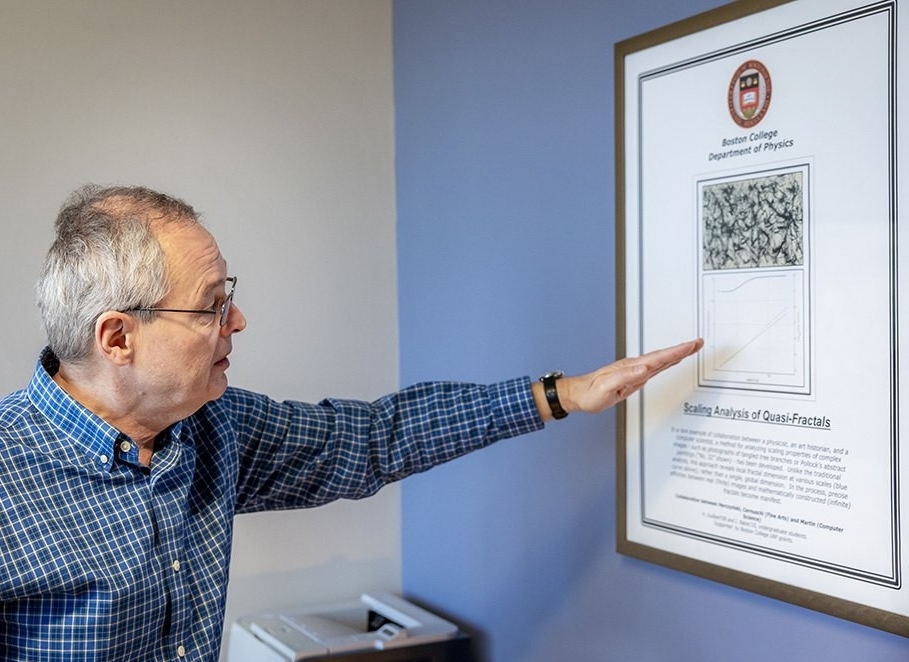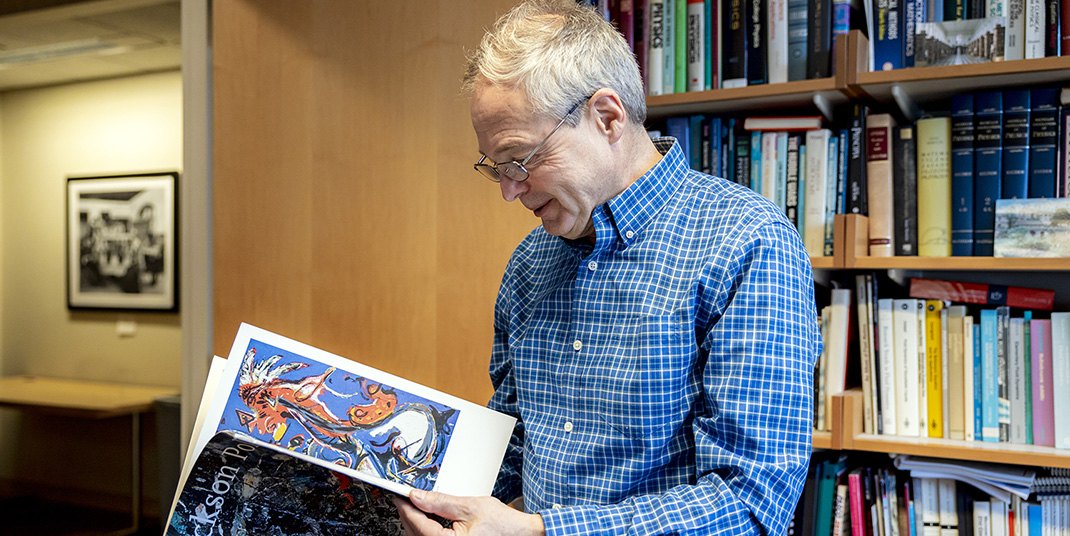Photos by Caitlin Cunningham
Boston College Physicist Andrzej Herczynski has received a two-year, $300,000 grant from the National Science Foundation to bring together researchers to explore the connections between mathematics, science and art.
Herczynski, a research professor and laboratory director in the Department of Physics, said the grant is intended to ignite creative collaboration among artists and scientists, as well as experts from a range of fields in the arts, sciences, and humanities, who endeavor to expand the boundaries of common understandings about the interplay of these fields.
“I am very excited to receive this grant,” said Herczynski. “This is a high-risk, potentially high-reward type of program that the NSF supports as a way of encouraging new ways of thinking and new ideas, which may make a long-term impact in math and science, and art as well, and the many ways these seemingly disparate disciplines connect with each other.”
Funding for the grant comes from the NSF’s EAGER (Early-Concept Grants for Exploratory Research) program, which supports “untested, but potentially transformative, research ideas or approaches,” according to the program website.
Developed in collaboration with Herczynski's colleagues at the Isaac Newton Institute at the University of Cambridge in the U.K., the program will expand on ideas that emerged during two workshops Herczynski organized there in 2017 and 2020, he said.
The project will create new opportunities for a dialogue with contemporary artists working in diverse media, stimulating new insights and new collaborative ventures, he said. In addition to conferences, research workshops, and discussion panels, a series of art exhibitions will be organized, both in the U.S. and the U.K., featuring prominent painters, sculptors, and other artists, whose work engages mathematics or physics in some way, whether directly or indirectly.

Physicist Andrzej Herczynski's previous studies have involved the abstract paintings of Jackson Pollock.
The intersection of art and science has long been a subject of personal and professional interest for Herczynski. As a physicist, his work has been focused on mathematical modeling in fluid dynamics. He has also worked with colleagues, including art historians, to bring physics sensitivity and mathematical tools to the understanding of the visual arts and music.
In 2007, he undertook a collaboration with then BC Professor of Art History Claude Cernuschi to examine scaling properties and fluid-dynamical effects in the abstract paintings of Jackson Pollock, who poured and sometimes dripped liquid paints—of varied physical properties—onto horizontal canvases to create some of the best-known works of the 20 th century. The research led to publications in several highly-regarded peer-reviewed physics and art journals.
“With Jackson Pollock, we brought fluid dynamics to analyze his particular technique, to gain an understanding of why his paintings look the way they do, and why he engaged in certain novel practices,” said Herczynski. “He was effectively experimenting with liquid pigments and we wanted to add the relevant physics to the study of his work.”
Beyond its applications to paintings, fluid and solid mechanics can be engaged to study sculpture, particularly works made from molten metal and other materials, forms that use granular substances, as well as works that depict the flow of liquids.
During his participation in programs in 2017 and 2020 at the Isaac Newton Institute, one of the world’s premiere centers for the study of mathematical sciences, Herczynski and his colleagues, the institute’s Curator of Art and Science Barry Phipps and its director, David Abrahams, began to formulate the grant proposal.
In addition to examining the intersection of these fields in the conceptualization and creation of works of art, the program will include the science of preserving and even reconstructing fragile or damaged works of art, noted Herczynski.
He envisions workshops and seminars, as well as related exhibitions, which will serve to illuminate such interdisciplinary issues as the role of artificial intelligence and its use in the creation of works of art; the effects of using a variety of tools—such as paint applicators, brushes, or sprays to create art objects; cultural connections between scientific discovery and artistic creation throughout history; questions of scale and scaling properties in physics and art; and how mathematical concepts are represented in artistic imagery.
“These themes are really invitations to engage in conversations across the traditional boundaries of fields,” said Herczynski. “We are hoping this will be a two-way street, resulting in new directions in physics research inspired by artworks and artistic processes. Simultaneously, we are hoping that those artists who allow physics to ‘co-author’ their pieces, may, through collaboration with scientists, hone-in and extend their techniques. That kind of cooperation may lead to creative leaps in art as well science.”
Ed Hayward | University Communications | December 2021




